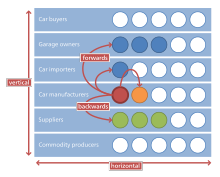Vertical integration is a business strategy where a company takes control of its supply chain[1]. This means that a company owns different stages of production, from the raw materials to the final product, and sometimes even the sales[2] process. This strategy is used to increase efficiency, secure supplies, and control markets. There are three types – backward, forward, and balanced integration. While there are benefits such as lower costs and increased profits, there are also challenges including high initial investment and potential conflicts of interest. Examples of successful vertical integration include companies like Apple, Amazon, and Tesla. This strategy can lead to increased market power and can disrupt traditional business models.
At microeconomics, management and international political economy, vertical integration is an arrangement in which the supply chain of a company is integrated and owned by that company. Usually each member of the supply chain produces a different product or (market-specific) service, and the products combine to satisfy a common need. It contrasts with horizontal integration, wherein a company produces several items that are related to one another. Vertical integration has also described management styles that bring large portions of the supply chain not only under a common ownership but also into one corporation (as in the 1920s when the Ford River Rouge Complex began making much of its own steel rather than buying it from suppliers).

Vertical integration can be desirable because it secures supplies needed by the firm to produce its product and the market needed to sell the product, but it can become undesirable when a firm's actions become anti-competitive and impede free competition in an open marketplace. Vertical integration is one method of avoiding the hold-up problem. A monopoly produced through vertical integration is called a vertical monopoly: vertical in a supply chain measures a firm's distance from the final consumers; for example, a firm that sells directly to the consumers has a vertical position of 0, a firm that supplies to this firm has a vertical position of 1, and so on.